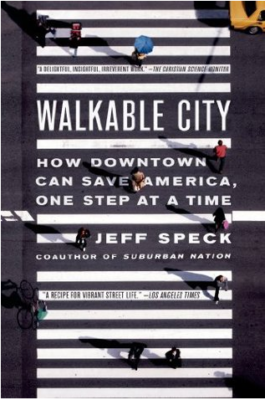Walkable City: How Downtown Can Save America, One Step at a Time

This is an engaging and readable book written by Jeff Speck of Washington, DC. I was captivated by the very first page and read all the way through to the annotated footnotes (which are quite interesting.)
Since I live in a small city, located in the middle of a huge county, next to our Nation’s Capital, this is not an academic exercise. We are in the midst of making decisions about redevelopment and roads that will impact Fairfax City for the next 50 years. If a project turns out to be ill conceived or poorly executed, we will still be stuck with it for decades.
The most striking aspect of this book is how “counter-intuitive” Speck’s advice appears to be. In other words, we tend to accept what I would term “commonly held notions” about traffic, roads, parking, economic development, housing and public transportation. SURPRISE! Just because a lot of people believe something to be true, doesn’t make it true. It just makes it something a lot of people believe.
So let’s try some data analysis, case studies, some actual . . . science.
One of my favorite “aha” moments is about Induced Demand.
Induced demand is the name for what happens when increasing the supply of roadways lowers the time cost of driving, causing more people to drive and obliterating any reductions in congestion.
Speck points out that “there have been so many incentives for driving, cars have behaved like water, flowing into every nook and cranny where they have been allowed.” So our quest to widen roads and reduce congestion only creates capacity for more congestion. Logical – right? So why do we continue to build more roads to try to “ease congestion” when the data shows it just creates more?
And parking! Donald Shoup’s book, The High Cost of Free Parking is “751 pages long and weighs three and a quarter pounds” and Speck quotes him extensively in this book. That’s another area where what we believe is not supported by the actual data about how people behave when given options. He also points out that parking requirements for development projects often make no sense at all when placed in the context of their location.
This book is fantastic. I feel like I am living in the middle of everything he addresses here . . . because I’m LITERALLY living in the middle of a small city on the cusp of major decisions regarding future development and how to manage traffic.
The fact that I created 150 bookmarks (which includes some of the footnotes) is testament to how valuable I think his points really are. I want LOTS of my friends and neighbors to read this book so we have a common vocabulary with which to discuss these concepts. I am no urban planner, but I live here, drive here, shop here and walk here. The better informed residents are, the more valuable our efforts in working with city council and city staff in supporting the ongoing development of a city focused on wealth, health, sustainability and yes – walkability!